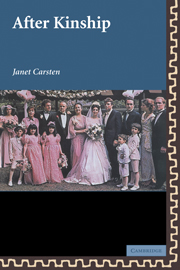Book contents
- Frontmatter
- Contents
- Acknowledgments
- 1 Introduction: After Kinship?
- 2 Houses of Memory and Kinship
- 3 Gender, Bodies, and Kinship
- 4 The Person
- 5 Uses and Abuses of Substance
- 6 Families into Nation : The Power of Metaphor and the Transformation of Kinship
- 7 Assisted Reproduction
- 8 Conclusion
- Bibliography
- Index
4 - The Person
Published online by Cambridge University Press: 05 June 2012
- Frontmatter
- Contents
- Acknowledgments
- 1 Introduction: After Kinship?
- 2 Houses of Memory and Kinship
- 3 Gender, Bodies, and Kinship
- 4 The Person
- 5 Uses and Abuses of Substance
- 6 Families into Nation : The Power of Metaphor and the Transformation of Kinship
- 7 Assisted Reproduction
- 8 Conclusion
- Bibliography
- Index
Summary
Diane Blood's protracted litigation in Britain to establish her claim to undergo artificial insemination using the sperm of her deceased husband, and Anna's long search in Scotland to make a connection to a birth mother from whom she had been separated since babyhood, are very much contemporary Western stories. These vignettes with which I began this book both apparently speak to very topical issues at the heart of how the person is perceived.
It seems of obvious significance that such stories can be framed around the importance of knowledge about genetic connection, or in terms of the “rights” of individual human beings. But I shall show in this chapter that it is also possible to read these stories in a different way, as illuminating how close kin ties are intrinsic to the social constitution of persons. The obviousness of this observation, which has long been central to anthropological analyses of how the person is constituted in many non-Western contexts, has been obscured by the assumption that kinship is of much more marginal significance in Western capitalist societies. So, this chapter sets out to do two kinds of work: to delineate some of the complexity, and the different sources, of Western ideas about the person, and also to trace the history of anthropological understandings of personhood crossculturally. Upsetting a rather oversimplified dichotomy between a Western individualized person and a non-Western “joined-up” person makes clear the centrality of locally and historically specific practices and discourses of relatedness.
- Type
- Chapter
- Information
- After Kinship , pp. 83 - 108Publisher: Cambridge University PressPrint publication year: 2003

